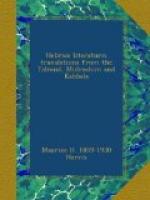Although the life of denationalized Israel was much narrower and more circumscribed, with fewer outlets to their capacities, nevertheless the new laws deduced from the Mishnah code in the academies grew far larger than the original source, while the discussions which grew around each Halacha, as the final decision was termed, and which was usually transmitted with the decision, grew so voluminous that it became gradually impossible to retain the complex tradition in the memory—remarkable as the Oriental memory was and is. That fact, added to the growing persecutions from Israel’s over-lords, and the consequent precarious fate of these precious traditions, made it necessary to write them down in spite of the prejudice against committing the oral law to writing at all. This work was undertaken by Rav Asche and his disciples, and was completed before the year 500. The Mishnah, together with the laws that later grew out of it, called also Gamara, or Commentary, form the Talmud. While the Palestinian school evolved a Gamara from the Mishnah which is called the “Palestinian Talmud,” it was the tradition of the Babylonian academies, far vaster because they continued for so many more centuries, that is the Talmud per se, that great work of 2,947 folio leaves. Were we to continue the tradition further, we might show how often this vast legal compilation was the subject of further commentary, discussion and deduction by yet later scholars. But that takes us beyond our theme and is another story.
In forming an estimate of these laws, we must first remember that they belonged to the days when religion and state were one. So we shall find priestly laws mixed up with police laws, sanitary regulations side by side with regulations of sanctity, the injunctions teaching political economy and morality almost in the same line. It should rather then be compared to codes of law than to religious scriptures, though often there the comparison would be incomplete, since the religious atmosphere pervaded even the most secular circumstance of the life of the Jew. There was no secular. The meanest function in life must be brought in relation to the great Divine. This must be understood in studying the Talmud, this must be understood in studying the Jew. As law, it compares favorably with the Roman code—its




